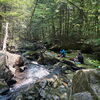Processing Your Payment
Please do not leave this page until complete. This can take a few moments.
- News
-
Editions
View Digital Editions
Biweekly Issues
- December 1, 2025
- Nov. 17, 2025
- November 03, 2025
- October 20, 2025
- October 6, 2025
- September 22, 2025
- + More
Special Editions
- Lists
- Viewpoints
-
Our Events
Event Info
Award Honorees
- Calendar
- Biz Marketplace
Stonington’s working waterfront history highlighted in new display
The working waterfront heritage in the Deer Isle town of Stonington is the focus a new interpretive display looking out onto its harbor.
The four-part display, the newest exhibit at Maine Center for Coastal Fisheries’ Discovery Wharf, highlights the commercial fish pier, local granite history, lobster fishery and resilience-building character.
The display is also one of 45 stops along the Downeast Fisheries Trail, which connects historic and active fisheries sites that illustrate the region’s maritime heritage from Penobscot Bay to Passamaquoddy and builds on local resources to strengthen community life and visitor experience.
“Stonington is at the heart of Downeast Maine’s rich fishing history,” Natalie Springuel, a Maine Sea Grant liaison and coordinator of the Downeast Fisheries Trail, said in a news release. “These interpretive panels will help visitors understand how that heritage connects to the larger region, from here to the Canadian Border.”
Maine's working waterfront
Maine has an estimated 5,300 miles of coastline, but just 20 miles of it is set aside for working waterfront, according to a report by the Rockland nonprofit Island Institute.
The report looked at 143 coastal municipalities and identified 1,555 points of access. Of those, 1,045 provided saltwater access that could accommodate commercial fishing or a water-dependent business.
"Working waterfronts collectively define the soul and character of Maine’s islands and coast, for residents and visitors alike. Nevertheless, Maine’s working waterfront faces tremendous pressure from conversion to other, incompatible uses," the report said.
Stonington's role
Stonington, at the southern end of Deer Isle, had a population of 1,056 in 2020. The Hancock County town's history has been closely tied with the granite industry and commercial fishing.
With its new working waterfront display, the goal is to help tourists understand that they're standing in a busy, lucrative seafood port, employing hundreds of people. Stonington's lobster industry depends on a strong and resilient shoreside infrastructure.
The display aims to highlight that economic engine and shed light on the fragility of coastal infrastructure in the face of a changing climate, said Pat Shepard, a collaborative research specialist with Maine Center for Coastal Fisheries and part of the team that designed and installed the signs.
“The panels help people dive a bit deeper into what it takes to move 200 million pounds of seafood from its point of origin into a global market,” Shepard said.
The panels were developed in partnership with Maine Sea Grant and the Downeast Fisheries Trail. They are located at Maine Center for Coastal Fisheries’ Discovery Wharf on the waterside of its building located at 13 Atlantic Ave.
The mission of Maine Center for Coastal Fisheries, on Stonington’s working waterfront, is to secure a diversified fishing future by connecting fishermen, scientists, regulators and others through collaborative research, education and management.
Mainebiz web partners

The Giving Guide
The Giving Guide helps nonprofits have the opportunity to showcase and differentiate their organizations so that businesses better understand how they can contribute to a nonprofit’s mission and work.
Learn More
Work for ME
Work for ME is a workforce development tool to help Maine’s employers target Maine’s emerging workforce. Work for ME highlights each industry, its impact on Maine’s economy, the jobs available to entry-level workers, the training and education needed to get a career started.
Learn More
Groundbreaking Maine
Whether you’re a developer, financer, architect, or industry enthusiast, Groundbreaking Maine is crafted to be your go-to source for valuable insights in Maine’s real estate and construction community.
Learn more-
The Giving Guide
The Giving Guide helps nonprofits have the opportunity to showcase and differentiate their organizations so that businesses better understand how they can contribute to a nonprofit’s mission and work.
-
Work for ME
Work for ME is a workforce development tool to help Maine’s employers target Maine’s emerging workforce. Work for ME highlights each industry, its impact on Maine’s economy, the jobs available to entry-level workers, the training and education needed to get a career started.
-
Groundbreaking Maine
Whether you’re a developer, financer, architect, or industry enthusiast, Groundbreaking Maine is crafted to be your go-to source for valuable insights in Maine’s real estate and construction community.
ABOUT
NEW ENGLAND BUSINESS MEDIA SITES
No articles left
Get access now
In order to use this feature, we need some information from you. You can also login or register for a free account.
By clicking submit you are agreeing to our cookie usage and Privacy Policy
Already have an account? Login
Already have an account? Login
Want to create an account? Register
Get access now
In order to use this feature, we need some information from you. You can also login or register for a free account.
By clicking submit you are agreeing to our cookie usage and Privacy Policy
Already have an account? Login
Already have an account? Login
Want to create an account? Register







0 Comments